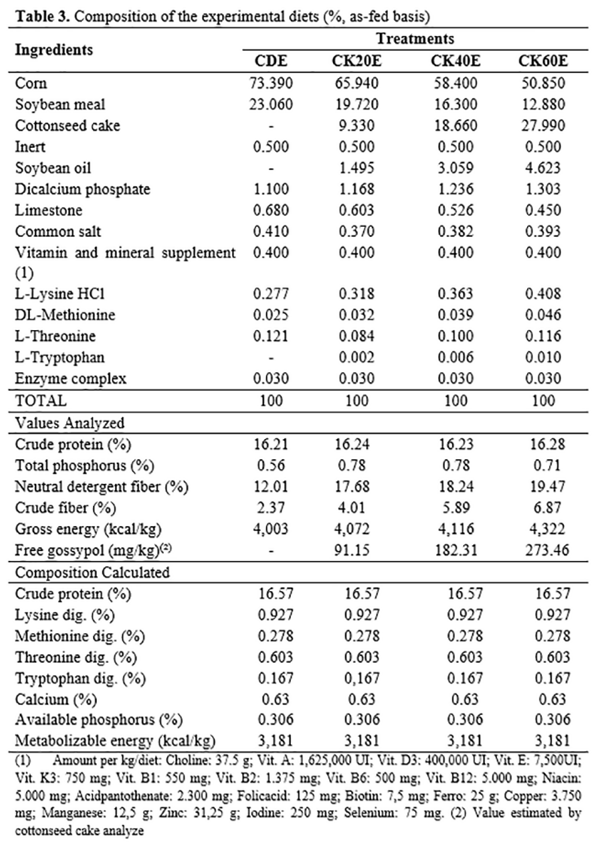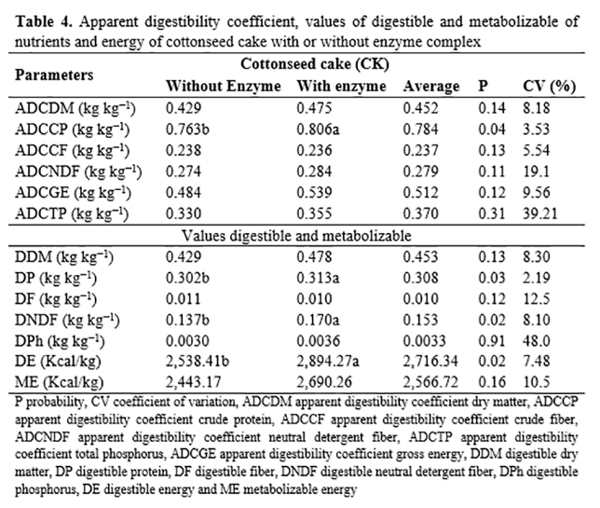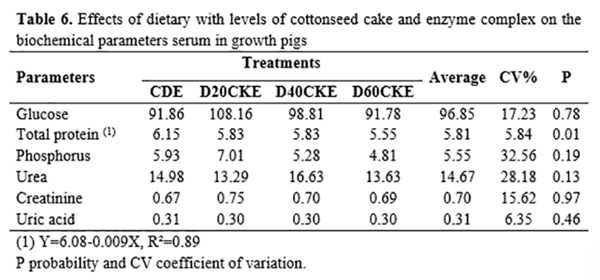Introduction
Co-products resulting from the seed of the cotton plant (Gossypium hirsutum L.) after oil extraction represent the third protein source available for animal feed worldwide, in accordance with Ash and Dohlman(1), and it is considered an excellent alternative to prepare feed for pigs. However, its application in feeding non-ruminants as a single protein supplementation in diets is limited, due to its high crude fiber. Diets with a high concentration of crude fiber increases peristalsis and, consequently, accelerates intestinal transit, decreasing the time of contact with the enzymes responsible for digestion, and the time available for absorption of nutrients(2).
An alternative to fiber degradation of cottonseed cake is the addition of a digestive enzyme complex to the feed. Exogenous enzymes promote the rupture of cell walls, reduce intestinal viscosity caused by non-starch polysaccharides, and suppress the effect of antinutritional properties present in foodstuffs(3). Enzyme supplementation can act as an important tool, efficiently facilitating digestion and increasing the availability of nutrients.
Thus, the working hypothesis is that the addition of the enzyme complex on diets base of cottonseed cake improves the nutrients digestibility, performance and carcass yield for pigs. The objectives of this study were to determine the nutritional value of cottonseed cake with and without an enzyme complex, and to identify the replacement level of soybean meal protein by cottonseed cake protein with the enzymatic complex supplementation in diets for pigs in the growth phase.
Materials and methods
All procedures used in the present experiment were submitted to the Ethics Committee on the use of Animals of the University Federal Rural of Pernambuco (CEUA-UFRPE) and was approved by license nº 069/2013. The experiments were conducted at the Swine Sector of the Department of Animal Science at UFRPE.
Cottonseed cake (CK) was obtained by mechanical pressing, after steam heating. The CK was treated with ferrous sulfate (FeSO4) in a 1:1 proportion (iron:free gossypol) before being added to the experimental diets, with the aim of avoiding gossypol effects.
The CK samples used in this experiment were analyzed for dry matter (DM), crude protein (CP), ether extract (EE), calcium and total phosphorus (TP) (Silva and Queiroz, 2005). Gross energy (GE) was determined via bomb calorimeter (IKA 200®), crude fiber (CF) was determined by following the method of Weende(7), and neutral detergent fiber (NDF) and acid detergent fiber (ADF) were determined using the method of Van Soest et al.(8).
Determination of the total amino acid composition of cottonseed cake was analyzed at Company Evonik Industries AG Feed Additives/Animal Nutrition Services, through near-infrared spectroscopy (NIR). The free gossypol (FG) of cottonseed cake was analyzed at Laboratory Labtron® using the methodology described by Pons and Guthrie(9).
The chemical composition of cottonseed cake is shown in Table 1.
Experiment I – Digestibility
Twenty growing crossbred barrows [(Large White x Duroc) x Landrace] with an initial body weight of 29.3 ± 2.81 kg were used to assess digestibility. The animals were housed individually in stainless steel metabolism cages, as described by Pekas(4), under an environmental temperature of 26.5 ± 2.27 °C (minimum) and 33.51 ± 1.07 °C (maximum), and relative humidity between 33.21 ± 2.20% (minimum) and 68.0 ± 9.55% (maximum). The experimental design was completely randomized, with four treatments and five replications, consisting of one pig perpen.
Treatments consisted of a reference diet (based on corn and soybean meal); a reference diet (based on corn and soybean meal) with the enzyme complex; a test diet (70% reference diet and 30% of cottonseed cake); and a test diet (70% reference diet and 30% of cottonseed cake) with the enzyme complex. The reference diet was formulated to meet or exceed Brazilian Tables for Poultry and Swine(5) (Table 2).
The evaluation of digestibility was performed by the method of total collection (feces and urine), for a trial period of ten days: five days were the adaptation phase and the other five days were collection.
The daily feed was defined through the metabolic weight (BW0,75) of each pig. It was provided in two equal parts, which were given at 08:00 and 16:00 h. Water was available ad libitum through a drinking nipple. The collection and sample preparation of feces and urine were conducted as per the method described by Sakomura and Rostagno(6). The samples were defrosted, homogenized for each animal and aliquots were taken. Feces samples were pre-dried in an oven with forced air ventilation at 55 ºC for 72 hours, with subsequent milling using a knife mill with a 1mm sieve and was collected for chemical analysis.
The samples used in this experiment were analyzed for dry matter (DM), crude protein (CP), ether extract (EE), calcium and total phosphorus (TP) (Silva and Queiroz, 2005). Gross energy (GE) was determined via bomb calorimeter (IKA 200®), crude fiber (CF) was determined following the method of Weende(7), and neutral detergent fiber (NDF) and acid detergent fiber (ADF) were determined using the method of Van Soest et al.(8).
Apparent digestibility coefficients were calculated for dry matter (ADCDM), crude protein (ADCCP), crude fiber (ADCCD), neutral detergent fiber (ADCNDF), gross energy (ADCGE), total phosphorus (ADCTP), and values of digestible dry matter (DDM), digestible protein (DP), digestible fiber (DF), digestible neutral detergent fiber (DNDF), digestible phosphorus (DPh), digestible energy (DE) and metabolizable energy (ME) of cottonseed cake, using the formulas described by Matterson et al.(10). Diets with the enzyme complex were used for calculating the composition of cottonseed cake with the enzyme complex.
All the evaluated variables were subjected to analysis of variance and comparison of means by the t test at the 5% probability level, using the statistical program Statistics Analysis System version 9.0(11), according to the following mathematical model:
Yji = µ + ti + eji,
in which Yij = dependent variables related to Apparent digestibility coefficients of animals receiving treatment i (cottonseed cake without enzyme and cottonseed cake with enzyme) in replicate j (1, 2, 3, or 4); µ = overall mean of the variable; ti = effect of treatment I (cottonseed cake without enzyme and cottonseed cake with enzyme); and eij = random error associated with each observation.
Experiment II – Performance trial
Twenty growing crossbred barrows [(Large White x Duroc) x Landrace] with initial body weight (BW) of 27.84 ± 2.96 kg were used to assess performance. The animals were individually housed in 1.20 x 3.10 m² pens with concrete floors. Each pen was equipped with a stainless-steel feeder and a nipple drinker. The environmental temperature was registered as 25.04 ± 2.09 °C (minimum) and 30.19 ± 1.21 °C (maximum), and relative humidity was registered at 36.05 ± 4.09% (minimum) and 69.94 ± 14.23% (maximum). The experimental design was assigned a randomized complete block, with four treatments and five replications. Pigs were blocked on the basis of BW.
Treatments consisted of the following diets: CDE – control diet, based on corn and soybean meal; D20CKE – CDE with replacement of 20% protein from soybean meal by the cottonseed cake protein; D40CKE – CDE with replacement of 40% protein from soybean meal by the cottonseed cake protein; D60CKE – CDE with replacement of 60% protein from soybean meal by the cottonseed cake protein. Protein value supplied by cottonseed cake replaced in 20% 40% and 60% the protein value provided by soybean meal in the diets. All diets contained the enzyme complex.
All the diets were formulated to meet the nutritional requirements of animals according to Brazilian Tables for Poultry and Swine(5) (Table 3), except for metabolizable energy, crude protein and available phosphorus, which were reduced by 1.5%, for the addition of the enzyme complex, aiming that the enzymes to release the nutrients retained by the non-starch polysaccharides.
Performance lasted 35 days:7 days to adapt to feed and 28 days to assess the animals’ performance. The animals had free access to drinking water and feed. Feed intake was recorded in order to determine average daily feed intake (ADFI). Body weight was measured at the beginning and end of the experiment in order to average body daily gain (ABDG) to compute the feed conversion ratio (FCR).
Carcass measurements were performed in vivo by ultrasound in the beginning and end of the experiment, using the ultrasound machine Pie Medical Model Aquila®. It measured the loin eye area (LEA), backfat thickness (BT) and depth of muscle (DM), following the method described by Dutra Jr. et al.(12).
Blood samples were collected in all the animals at the end of the experiment from the orbital sinus of animals using hypodermic needles (40 x 1.6 mm). These were stored in 10 mL tubes without anticoagulant to obtain serum and 5 mL tubes with sodium fluoride and ethylenediaminetetraacetic acid (EDTA) to obtain plasma. Tubes with samples were centrifuged in 3,000 rpm, for 10 minutes, separating the serum and plasma. This was transferred to a microcentrifuge tube with identification. Serum samples were submitted to the following analyses: total protein, urea, uric acid, creatinine and phosphorus. The plasma sample was analyzed for glucose. All samples were analyzed using a SemiAutomatic Biochemistry Analyzer (Doles D250®) and commercial kits, according to the manufacturer’s instructions.
Data were subjected to analysis of variance by applying the PROC GLM procedure of Statistics Analysis System version 9.0(11), according to the following mathematical model:
Yij = µ + ti + eij,
in which Yij = dependent variables related to performance, digestibility, and blood parameters of animals receiving treatment i (cottonseed cake level: CDE, CK20E, CK40E or CK60E) in replicate j (1, 2, 3, 4 or 5); µ = overall mean of the variable; ti = effect of cottonseed cake level i; and eij = random error associated with each observation.
Regression analyses subjected variables for which significant effects were detected as a function of cottonseed cake, adopting a 5% probability level. The PROC REG statistical package of Statistics Analysis System version 9.0(11) was applied to obtain the regression equations and thus estimate the cottonseed cake level. The variables referring to carcass characteristics were submitted to analysis of variance and repeated measure, using the data of 20 barrows assessed at two different times (initial and final).
Results
Experiment I
The addition of the enzyme complex affected digestibility coefficient for crude protein and digestible protein values of cottonseed cake (p< 0.05) (Table 4). The highest values were recorded in CK with addition of complex enzymatic, and the same occurred with digestible neutral detergent fiber and digestible energy (p< 0.03). The addition of the enzyme complex did not affect metabolizable energy, though it did provide an increase of approximately 250 kcal/kg with the addition of enzymes.
Experiment II
The increasing levels of replacement protein from soybean meal by the cottonseed cake did not affect the general performance or carcass characteristics of the animals (p> 0.05) (Table 5).
The total serum protein of the pigs showed a linear reduction, by approximately 10%, with increasing levels of CK in the feed (p< 0.001). However, the glucose, phosphorus, urea, uric acid and creatinine levels were not affected by treatments.
Discussion
Experiment I
The higher apparent digestibility coefficient crude protein and digestible protein values suggest that the presence of the enzymatic complex could improve the availability of nitrogen from CK, increasing the use of low availability protein or combining with antinutritional factors. The increase of free nitrogen may have occurred through no-starch polysaccharide (NSP) hydrolysis. No-starch polysaccharide acts as a physical barrier to the digestion and absorption of nutrients, due to increase intestinal viscosity(13).
The increase of approximately 24% digestible neutral detergent fiber emphasizes the enzymatic complex performance on NSP hydrolysis, extending the enzyme action to fractions of less available food, increasing digestibility and causing more free monosaccharides, because the enzyme complex used was mostly compounds of carbohydrase. This explains the increase of digestible energy with the addition of the enzyme complex, showing that the enzyme complex may provide higher digestible energy, through making use of the fiber contained in the food.
Experiment II
According to the performance and carcass characteristic results for growing pigs, replacing protein from soybean meal with cottonseed cake protein by up to 60%, with the enzyme complex addition, can be done without sacrificing the performance and carcass characteristics. In this research, the maximum inclusion of the cottonseed cake in the diets was 27.99%. However, a different response was found by FombadandBryant(14), who recommended that the maximum level of CK for inclusion in pig feed was 15% (but without enzymes). This demonstrates the utilization efficiency of the enzyme complex in pig diets when the food contains a high level of fiber.
The linear decrease (P< 0.05) in serum total protein according to cottonseed cake levels added to the diets could be associated with the presence of gossypol and the low composition of lysine and tryptophan on cottonseed cake.
The cottonseed cake is an excellent protein source for pigs, although there is an anti-nutritional factor, gossypol (C30H30O8), a toxic polyphenolic compound, which acts as an inhibitor of enzymes activity causing the nutritional reduction of the cottonseed cake(15).
During the cottonseed oil extraction, the gossypol readily binds with amino acids constituents of the cotton protein, especially to the amino group of lysine and thereby reducing proteolytic action(16).
Gossypol binds to lysine, resulting in a complex form that non-toxic to animals, the gastrointestinal tract does not absorb this complex, but this causes decrease lysine availability and protein digestibility(17).
The reduction of 1.5% of crude protein in the diets should also have intensified this result; aiming to replace the nutritional value of the standard diet through the enzyme complex addition it was performed the reduction of nutrients whereas in balanced diet the enzymes cannot show its effectiveness.
When growing pigs are well fed, they show a total serum protein concentration of 7.9–8.0 g/dL(18). It can be observed that all the animals were below the normal concentration, and this indicates that the protease activity from the enzymatic complex was not very efficient to replace the decreased 1.5% requirement of the diets. However, the total serum protein decrease did not influence the animals’ performance. Decreasing protein in diets for pigs in the growth phase can result in a delay in body development and low muscle deposition, although, as the LEA was not reduced. Glucose levels were not influenced by diets and were within the normal concentrations of 85 to 150 mg/dL for swine(18), demonstrating the enzyme complex efficiency on the release of glucose, despite the reduction of 1.5% ME of the diets.
Conclusions
In general, the enzyme complex rather increases the digestible protein, neutral detergent fiber, and energy of the cottonseed cake during the grower phase of pigs.
The diet, containing replacement level of soybean meal protein by cottonseed cake protein at the level of 60% with the enzymatic complex supplementation, did not affect performance and carcass characteristics of pigs in the growth phase.
Acknowledgements
The authors would like to thank the Instituto Nacional de Ciência e Tecnologia de Ciência Animal (INCT-CA), CNPq and Bioenzima for financial resources.
This article was originally published in Ciencia Animal Brasileira, Goiânia, v.20, 1-11, e-56524, 2019. http://dx.doi.org/10.1590/1809-6891v20e-56254. This is an Open Access article distributed under the terms of the Creative Commons Attribution License. 














